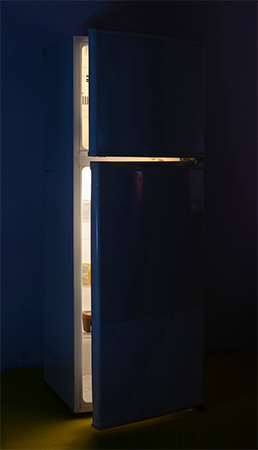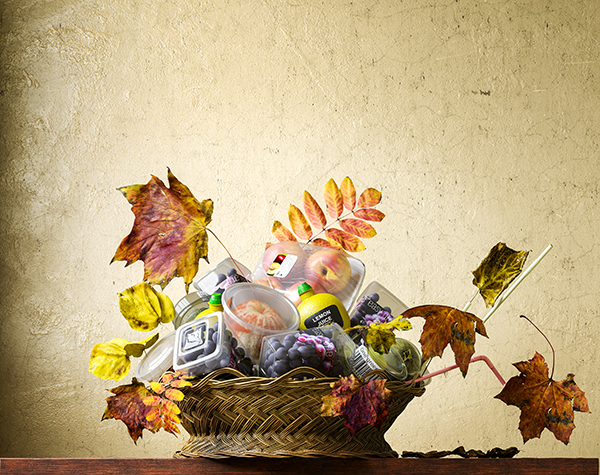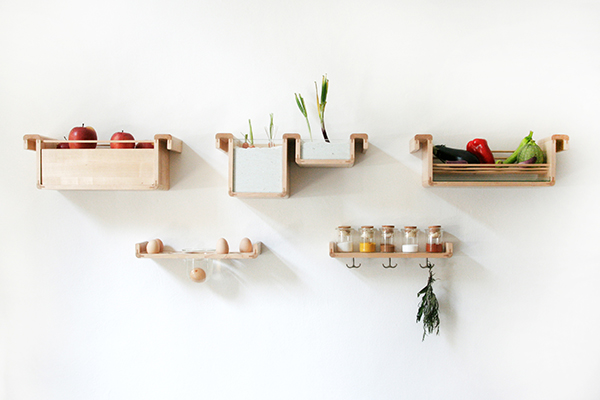
Refrigerator Illusion
- Period 2021.07.02.~2021.09.26.
- Location ACC Creation Space 3 & 4, Asia Culture Center
OPEN YOUR FRIDGE!
Let go of your illusions about its convenience and efficiency—and take a look at its hidden sides
The Refrigerator Illusion exhibition started with an attempt to use the refrigerator—an everyday essential and a part of everyone’s kitchen—as a lens for approaching culinary and lifestyle culture practices associated with “clothing, food, and shelter,” a major research focus for Asia Culture Research Institute (ACRI) at ACC/ACI.
Humankind’s first use of fire around 200,000 years ago brought about a revolution in food and lifestyle culture. In contrast, the history of our production and commercialization of home refrigerators accounts for only around a century of that long process of human efforts to develop the cooling technology that would allow us to “conquer the cold” by making our own artificial ice. Over that relatively short history, advancements in cooling technology and refrigerators have ushered in revolutionary changes in food storage, distribution, and consumption, as well as all aspects of our food and lifestyle culture. Thanks to refrigerators and a cold chain system that keeps food fresh at low temperatures over long periods of time, we no longer need to shop daily for fresh groceries, and we are able to consume the foods we want whenever we want, regardless of season or place of origin. There is no more need for us to expend the kinds of efforts we once did to preserve and store seasonal vegetables and fruits for long periods of time the way we did when there were no refrigerators.
PART 3. BIG FRIDGE SMALL WORLD
How have so many different food items been produced and distributed to wind up in our refrigerators?
The act of keeping food in our refrigerator ties in with global food system issues encompassing the stages of production, distribution, and consumption—including which foods we choose to consume, how food is produced and distributed, and what is done with the food waste left behind after our final consumption.
The third part focuses on different issues and topics surrounding refrigerators and food within the capital global food system, such as the mass production and long-distance distribution of food that evolved with advancements in refrigeration and freezing technology and industry (including the concepts of the “cold chain system” and “food miles”); meat-eating culture and factory farming (Unhappy Circuit); issues of colonial history, labor, and the environment on the underside of the global food trade and related systems (Elia NURVISTA); the problematic food consumption culture of today (Quatre Caps); and the matter of food waste resulting from indiscriminate food consumption and faulty storage (Kosuke ARAKI). In the same context, it also looks forward to a better present and future through the messages and meditations of different actors who are practicing alternative forms of food production, distribution, and consumption (Rice Brewing Sisters Club).
But is there another side to the convenience and efficiency of the refrigerator that we have forgotten or overlooked? What sorts of impacts are we having on humankind and the environment in exchange for the comforts and conveniences that we’ve adopted, as exemplified by the refrigerator? Moreover, as human beings today face crisis situations with rising populations, resource depletion, and climate change, is it really healthy and sustainable for us to continue with our refrigerator-dependent food storage, production, distribution, and consumption patterns within the capitalist global food system?
Originating in these questions, the exhibition Refrigerator Illusion looks at the history of human efforts to control the cold, the evolution of refrigerators, and changing patterns of food and lifestyle culture. Through the work of visual artists, designers, and makers together with documentary film footage and broadcast content, it attempts to share the various issues and the stories that exist on the other side of the convenience and efficiency that the refrigerator brings us. We also look forward to providing a setting for considering and discussing better methods of food storage and consumption, as well as healthier and more sustainable foods and food cultures for the sake of the future.
Curated by Soyean GOAK, Hyoyoon SHIM (Asia Culture Institute)
PART 1. CHRONICLE OF THE COOLNESS
When did refrigerators become essential to our kitchens and daily lives?
How did people store food before the refrigerator’s invention? What changes did the refrigerator bring to our food and lifestyle culture?
The first part presents a chronology, work by an artist, and advertising materials as it shares historical information, knowledge, and stories related to ice and refrigerators. Consisting of various actual resources and texts along with an archive of photographs and videos, “Chronicle of the Coolness: An Incomplete Timeline” adopts a diachronic historical perspective as it looks at the process from the first human use of ice to store food through the development of cooling technology, the emergence and evolution of refrigerators, and changing practices of food distribution. As an extension of this, it connects past and present by way of a project by a contemporary artist (Jun YANG) based on historical stories of the use and storage of ice in ancient China. Finally, it attempts a “reading” of refrigerator advertisements, sharing the sociocultural contexts and images of society shown in those ads and considering them from the perspectives of emulation of “advanced countries,” sanitation and health, gender, and food industry development.
Chronicle of the Coolness: An Incomplete Timeline
Humankind went from the stage of harvesting and using natural ice to store food to creating its own artificial ice by way of machines. In the process, it discovered safe, non-explosive refrigerants, and the home refrigerator was finally developed in the early 20th century. Before, humans had used fire to cook with—but with ice, they could store food for distribution throughout the world. Whereas humankind learned to control fire around 200,000 years ago, the history of our complete command of ice dates back only around a century. Raising temperatures was easy, but lowering them was far from simple. Once we gained our free command over ice, the result was a revolution for our dinner tables.
This timeline traces the process of humankind gaining control over the cold, from our first use of ice to store food through the development of cooling technology, the emergence and evolution of refrigerators, and changing practices of food distribution
Reading Refrigerator Advertisements
To the people encountering them for the first time in their lives, refrigerators were a marvel. The expensive appliances took pride of place in the home. Since the birth of refrigerators, people have harbored hopes and fantasies toward the items, rather than feelings of aversion. How did these boxy, strange-looking items with their seemingly provincial white color scheme become so beloved? Why did people back then regard refrigerators as sophisticated and elegant? Refrigerators became naturally integrated with people’s lives, almost as though they had always been there in Korean kitchens. Through advertisements, we can glimpse images of past eras and sociocultural contexts, reading the true story behind the emergence of these “kitchen superstars.”
PART 2. OPEN YOUR FRIDGE!
The different stories, perspectives, and views on the other side of the refrigerator
The second part looks at different issues and problems that exist on the other side of the “refrigerator illusion” of convenience and efficiency. It shares ACRI columns that talk about refrigerators in different households, including the traditional Korean “eldest son’s family,” the younger generation, people without family or friends, and multicultural families. It also presents different perspectives and attitudes from contemporary artists approaching the topic of “refrigerators.”
This part includes drawings that link the columns of ACRI with landscapes and objects as seen from the artist’s perspective (Sangun HO); an object/archive installation that uses refrigerators as a lens to address the issue of the senior citizens’ generation in a hyperaging society (Meewha LEE / E. J. Domoso); a media installation for which refrigerator-related data have been gathered, deconstructed, analyzed, and visualized (Minje JEON); an installation work that incorporates the refrigerator as a material in an attempt at a sculptural reversal (Goen CHOI); and a video work that explores the relationship between technology and human beings from an expanded perspective (TAO Hui).
PART 4. KITCHEN WITHOUT FRIDGES
Can we imagine kitchens—or life—without fridges?
Most people blindly trust that all groceries can be safely stored in the refrigerator, regardless of their individual characteristics. But as we have come to rely more and more on refrigerators, we have also lost sight of everyday knowledge passed down from history—things that may be useful as techniques for food storage.
With that in mind, the fourth part considers ways of recovering traditional everyday know-how that does not depend on refrigeration, through the lens of different works of art and forms of practice related to preserving and storing food. These include methods of food preservation that employ traditional knowledge and research on the inherent properties of certain ingredients (Jihyun David); food preservation and storage methods using “appropriate technology” (Noplug People); and stored foods from the Gwangju/Jeollanam-do region that incorporate techniques such as salting, fermentation, and drying (Jangdong Collective). The process of fermentation as one of humankind’s longstanding methods of food storage is used as a medium for relating a particular dish (pla-ra) to the nature, lives, and identity of Isan, the northeastern part of Thailand (Adisak PHUPA); or expanded to the societal level through its consideration as a methodology of artistic practice and a means of forming relationships among human beings, and between human and non-human beings (Rice Brewing Sisters Club).
Guide

Jun YANG
〈The Emperor of China’s Ice/ An Artist who Buried 1000kg of Ice in the Ground〉, 2019.

Sangun HO
〈Around the Refrigerator〉, 2021.
Goen CHOI
〈Material Pool: 2021 ACC〉,
Minje JEON
〈In God We Trust〉,

Meewha LEE / E. J. Domoso
〈2,000kcal–0kcal〉, 2021.
TAO Hui
〈Smoke and Light〉,
EBS Knowledge Channel e
〈The Longest Minute〉,
〈The “Three Kilometers a Week” Diet〉,

Quatre Caps
〈Not Longer Life〉, 2019.
Screening Room
〈Screening Room〉,
Unhappy Circuit
〈Frozen Monuments for Humanity〉,
Kosuke ARAKI
〈Food Waste Ware〉,

Elia NURVISTA
〈Gastronocene〉, 2021.

Rice Brewing Sisters Club
〈Sunhwan Belt〉,

Jihyun David
〈Save Food from the Fridge〉, 2009.
Noplug People
〈Ancient Future of Storages〉,
Rice Brewing Sisters Club
〈Social Fermentation Archive〉,

Jangdong Collective
〈Gut (good) Place: For Every Jo Wangs〉, 2021.
